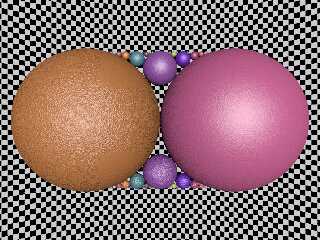|
 |
MichaelJF <fri### [at] t-online de> wrote:
> In my opinion, a special case was still missing here...
>
> Blue is an osculatory sphere packing with an asymmetric start
> configuration, red is a classical apollonian sphere packing with a
> symmetric start configuration.
>
> Best regards,
> MIchael
Yes, eventually we had to do the 3D version!
I had some papers on my pile (Well, _one_ of my piles) related to this.
How much more difficult was it to do the spherical space-filling version?
I'm also curious if this can be massaged into a macro that is capable of filling
any given arbitrary shape.
Then we could use it to build stone walls, layered geologic strata, sandstone
sculptures, etc.
Do a test scene with smooth spheres, and then enhance it by replacing them all
with isosurface rocks, pebbles, and sand.
A bowl of grapes. That sort of thing. :)
Excellent work - you ought to be proud.
- BW de> wrote:
> In my opinion, a special case was still missing here...
>
> Blue is an osculatory sphere packing with an asymmetric start
> configuration, red is a classical apollonian sphere packing with a
> symmetric start configuration.
>
> Best regards,
> MIchael
Yes, eventually we had to do the 3D version!
I had some papers on my pile (Well, _one_ of my piles) related to this.
How much more difficult was it to do the spherical space-filling version?
I'm also curious if this can be massaged into a macro that is capable of filling
any given arbitrary shape.
Then we could use it to build stone walls, layered geologic strata, sandstone
sculptures, etc.
Do a test scene with smooth spheres, and then enhance it by replacing them all
with isosurface rocks, pebbles, and sand.
A bowl of grapes. That sort of thing. :)
Excellent work - you ought to be proud.
- BW
Post a reply to this message
|
 |
|
 |
I plugged a prompt into the AI at work, just to see what sort of quality the
code and algorithms the thing spit out - and they're not all that terrible.
So I got some Ford Circles worked out (not using inversion).
Now, even this small experiment taught me some things.
spherical warp requires "orientation" and "dist_exp" to work properly,
especially as an interior_texture - otherwise you just get bad results.
And somehow, there may be a bug somewhere, or I'm just picking up some oddity in
the way the scene elements interact with each other - because I'm getting odd
"checkering" on that left-hand large sphere. The crackle normal gets
flattened/canceled out.
If I remove the large, enclosing checkered sphere, it goes away.
Enjoy.
// ------------------------------------------------------------------------
#version 3.8;
global_settings {
assumed_gamma 1.0
}
//#default {finish {emission 1}}
#declare E = 0.00001;
camera {
location <0.5, 0.5, -1.75>
right x*image_width/image_height
up y
look_at <0.5, 0.5, 0>
}
//sky_sphere {pigment {rgb 1}}
#declare BW = pigment_map
{
[0 rgb 0]
[1 rgb 1]
}
sphere {0, 1000 texture {pigment {checker rgb 0 rgb 1 scale x*0.5 warp
{spherical orientation y dist_exp 0.75} scale 1 }} } //interior_texture {pigment
{checker scale 1 }} }
light_source {<5, 5, -50> rgb 1}
#declare Line = 0.001;
#declare Seed1 = seed (123);
#declare Seed2 = seed (456123);
#declare Seed3 = seed (456123789);
#macro FordCircle (p, q, mode)
#local R1 = rand (Seed1);
#local R2 = rand (Seed2);
#local R3 = rand (Seed3);
#local Color = <R1, R2, R3>;
#local Radius = 1 / (2*pow(q,2));
#local Center = <p/q, Radius, 0>;
#switch (mode)
#case (0)
torus {Radius, Line pigment {rgb y} rotate x*90 translate Center}
torus {Radius, Line pigment {rgb y} rotate x*90 translate <1, -1, 1>*Center
translate y*1}
#break
#case (1)
disc {Center, z, Radius, 0 pigment {rgb Color}}
disc {Center, z, Radius, 0 pigment {rgb Color} translate <0, 1-Radius*2, 0>}
#break
#case (2)
sphere {Center, Radius texture {pigment {rgb Color} normal {crackle scale 0.01
bump_size 2} finish {specular 0.4}} }
sphere {Center, Radius texture {pigment {rgb Color} normal {crackle scale
0.01} finish {specular 0.4}} translate <0, 1-Radius*2, 0>}
#break
#end
#end
#macro gcd (a, b)
#if (b = 0)
#local Result = a;
#else
#local Result = gcd (b, mod (a, b));
#end
Result
#end
#declare max_q = 10;
#for (q, 1, max_q)
#for (p, 0, q)
#if (gcd (p, q) = 1)
FordCircle (p, q, 2)
#end
#end
#end
Post a reply to this message
Attachments:
Download 'fordcircles_ai.png' (824 KB)
Preview of image 'fordcircles_ai.png'

|
 |




![]()